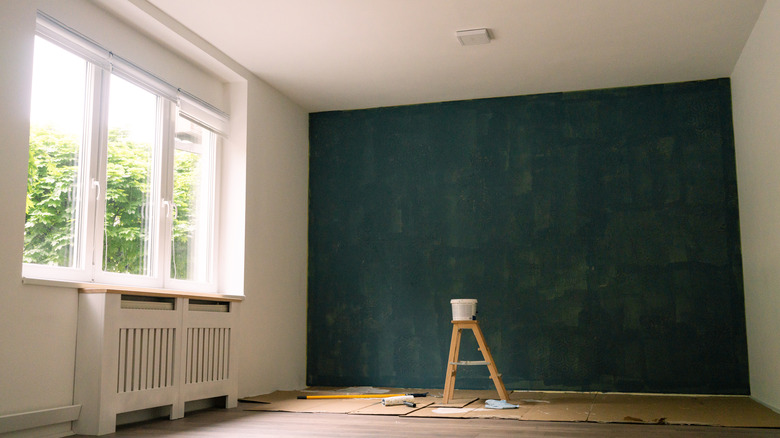Are You Making This Big Mistake When Painting Over A Dark Wall?
The thrill of a DIY paint job can be unparalleled. After all, it allows you to color your space according to your vision. Whether you opt for a serene pastel or a vivid accent hue, if you are painting over a dark wall, you may encounter some difficulties. One mistake many make when taking on such a project is spreading the paint too thin.
A thin layer might suffice when painting over a light wall with a darker shade because the undertones are less likely to peek through, but when the roles are reversed, and you're going from dark to light, thin coats will not do the trick. Painting over dark walls with a light color and expecting full coverage with one coat is a dream that is seldom realized. A thinly spread layer will often result in the dark undertones stubbornly showing.
So, how can one combat this? Remember this simple golden rule: Always add more paint than you think you need. Think heavy coverage. However, this doesn't mean you drown your walls in paint, but rather that you ensure you're generously applying it the right way. Consider rolling the paint on the wall in large "M" or "W" shapes. This is not just an artistic choice — it has a science behind it. Painting in these shapes allows parts of the paint to start drying instead of repeatedly covering it again with continuous vertical strokes. This technique ensures even coverage and reduces the chance of dark patches peeking through.
The art of layering
If you're aiming for a drastic dark-to-light transformation, arm yourself with patience. Every layer is a step closer to bringing your vision to life. Understanding that such a change won't happen right away is vital. The more extreme your color transition, the more layers you'll need — two at least. For a rough estimate, painting over a dark wall with a significantly lighter shade can make one wall a half-day project. While it might seem tedious, the final result will be worth it.
However, it is important to note that you must use a primer first before you go in with the paint. Primer not only acts as a sort of glue for the paint to stick to, but it also helps mute out some of the dark wall color. Without it, you'd likely have to use many coats of paint to fully cover it. Contrary to the common belief that using a mid-tone primer, like gray, is the best choice for all situations, the actual best practice is different. Use white primer when transitioning from a dark to a light color and gray primer when transitioning from light to dark.
As you embark on your painting journey, keep in mind that the key to success lies in persistence and understanding your medium. Paint is not just about color, but consistency, layering, and technique. Do not be discouraged if the first coat doesn't give you the result you desire. Keep layering until the dark undertones are completely obscured. By the end of the process, when you stand back and admire your work, you'll realize that the time and effort invested were worth the beautiful transformation.

